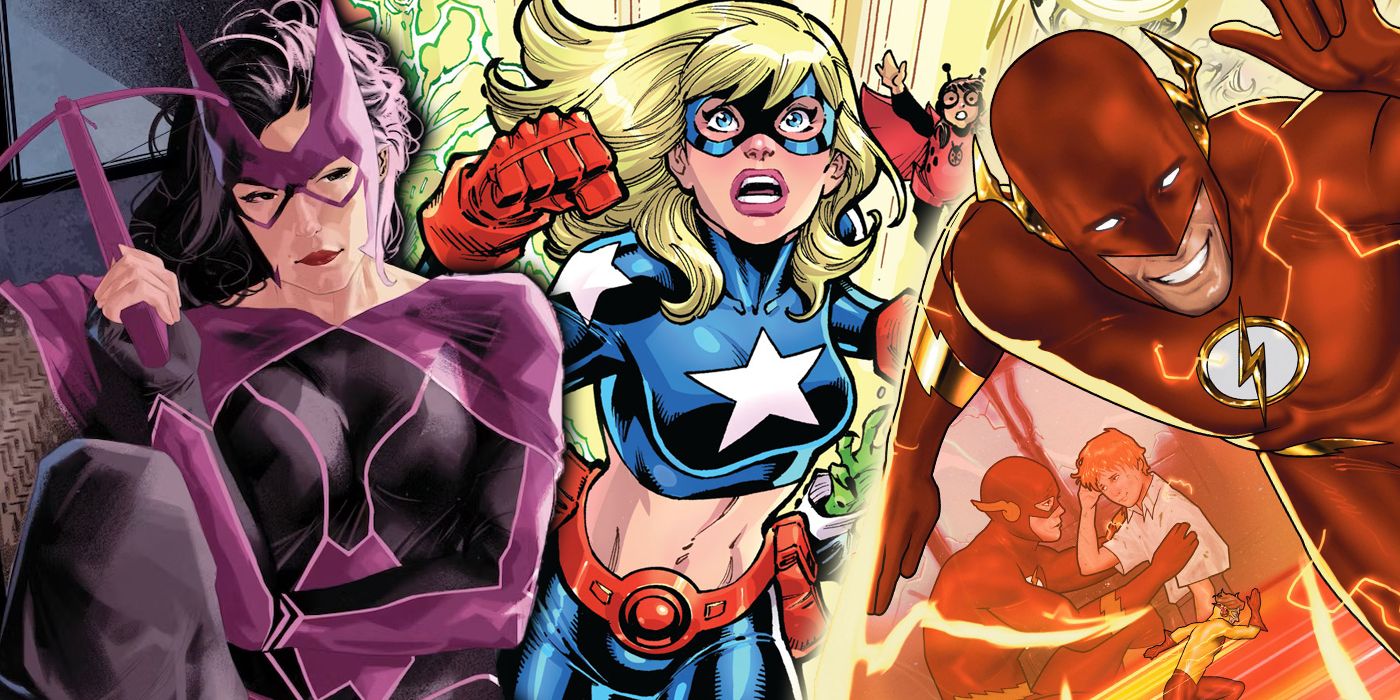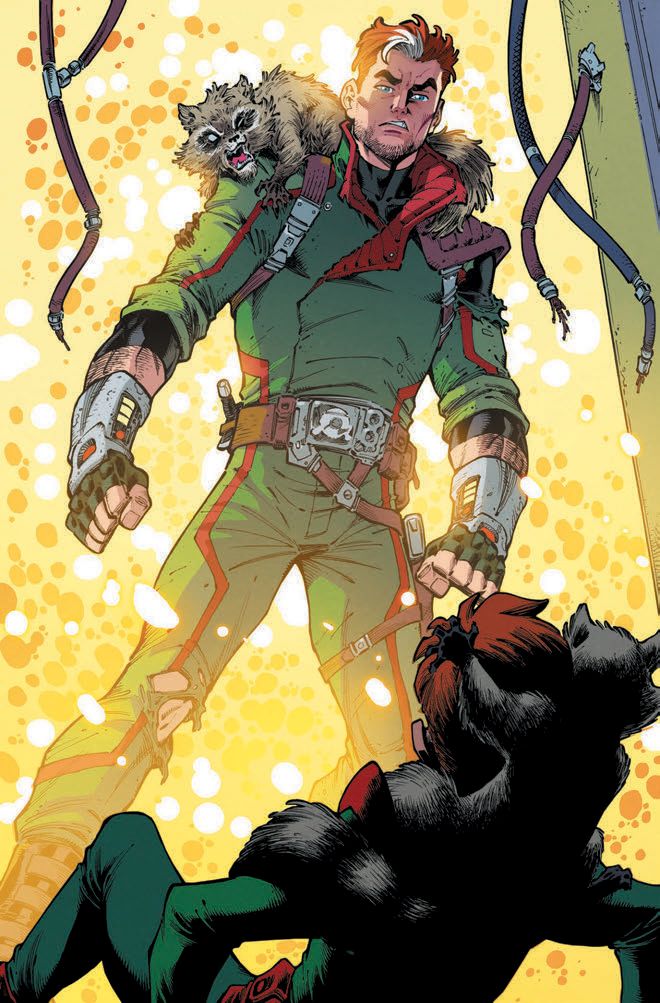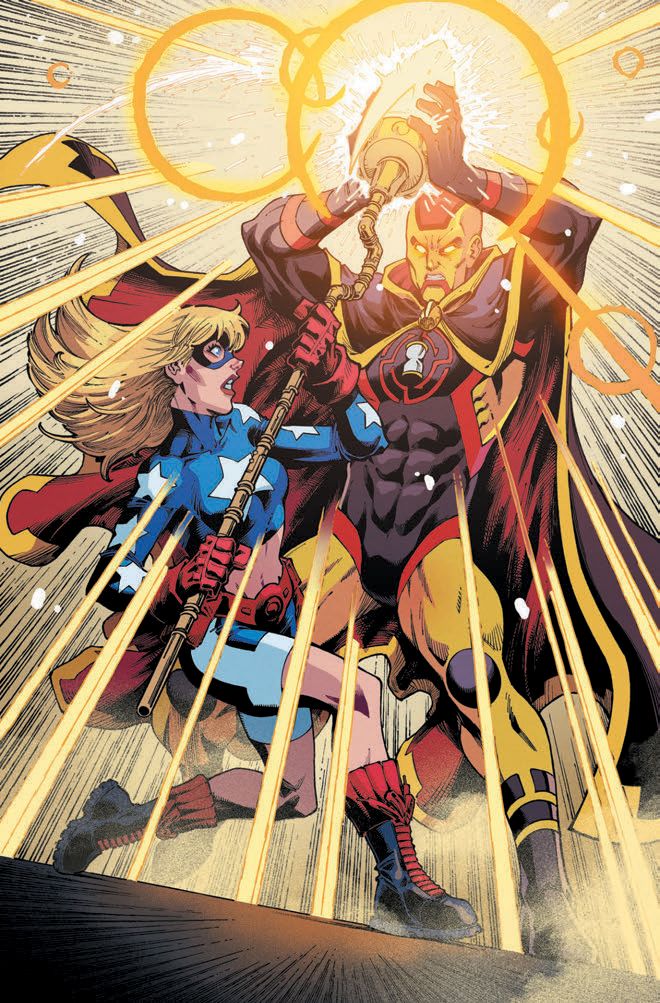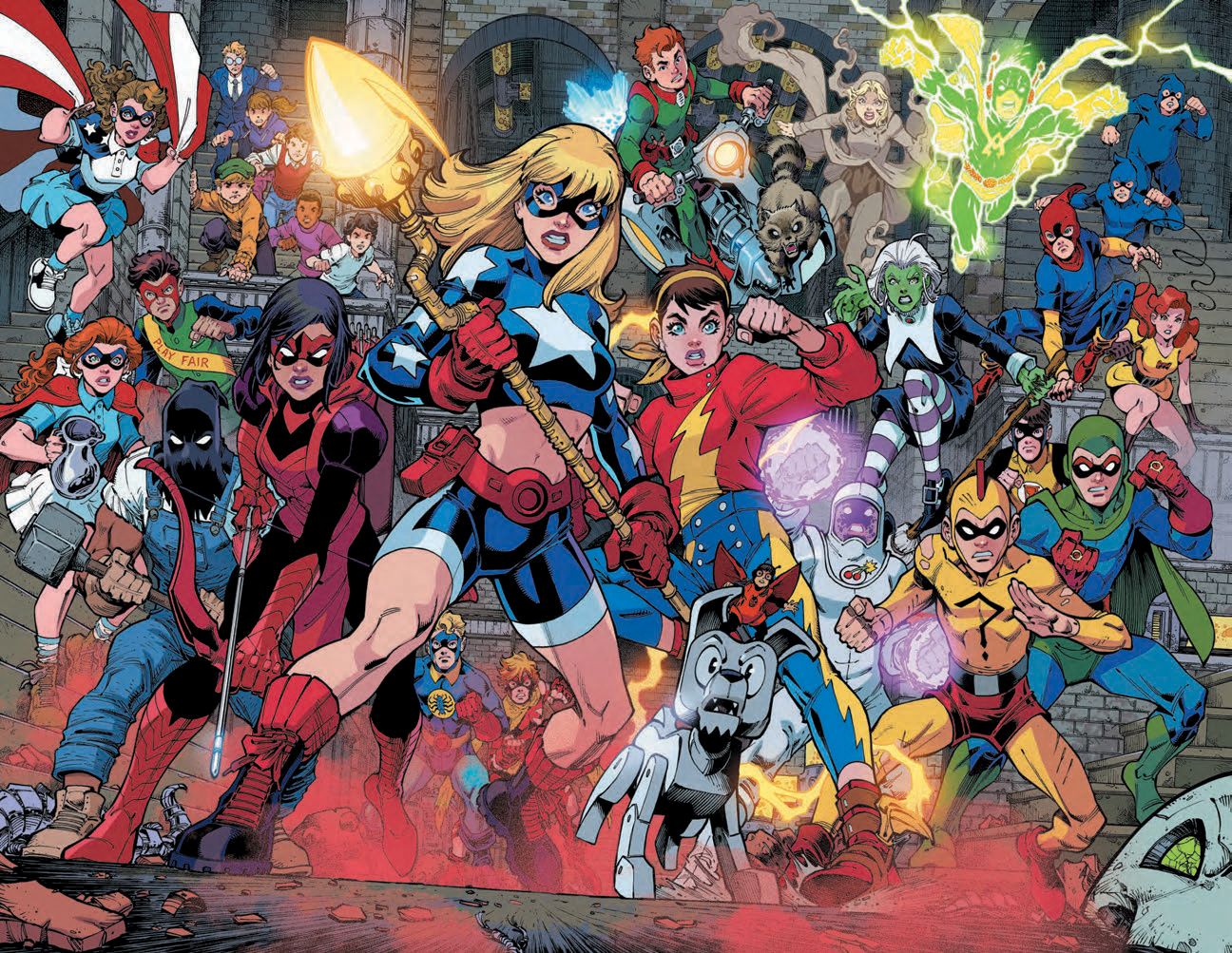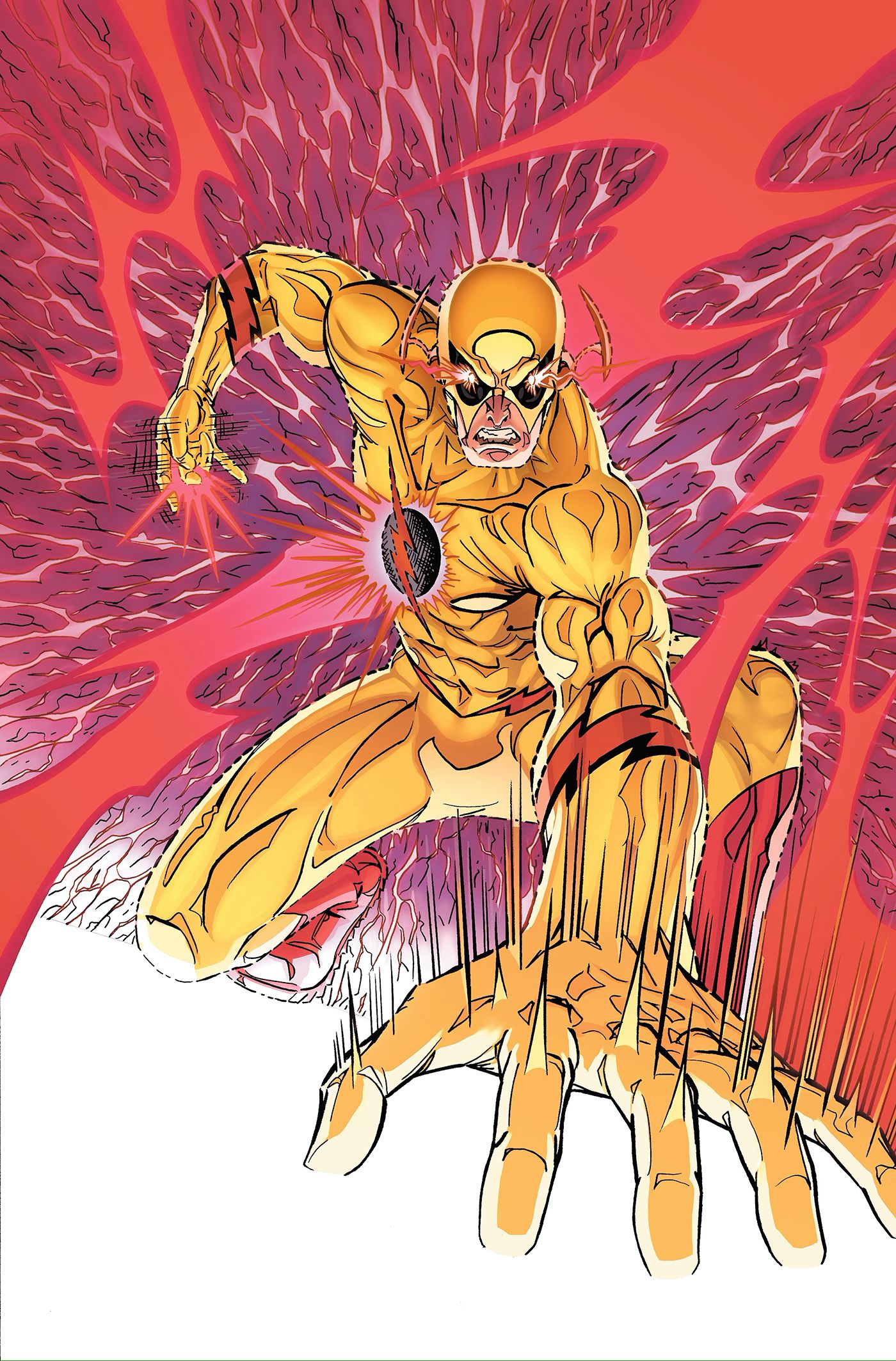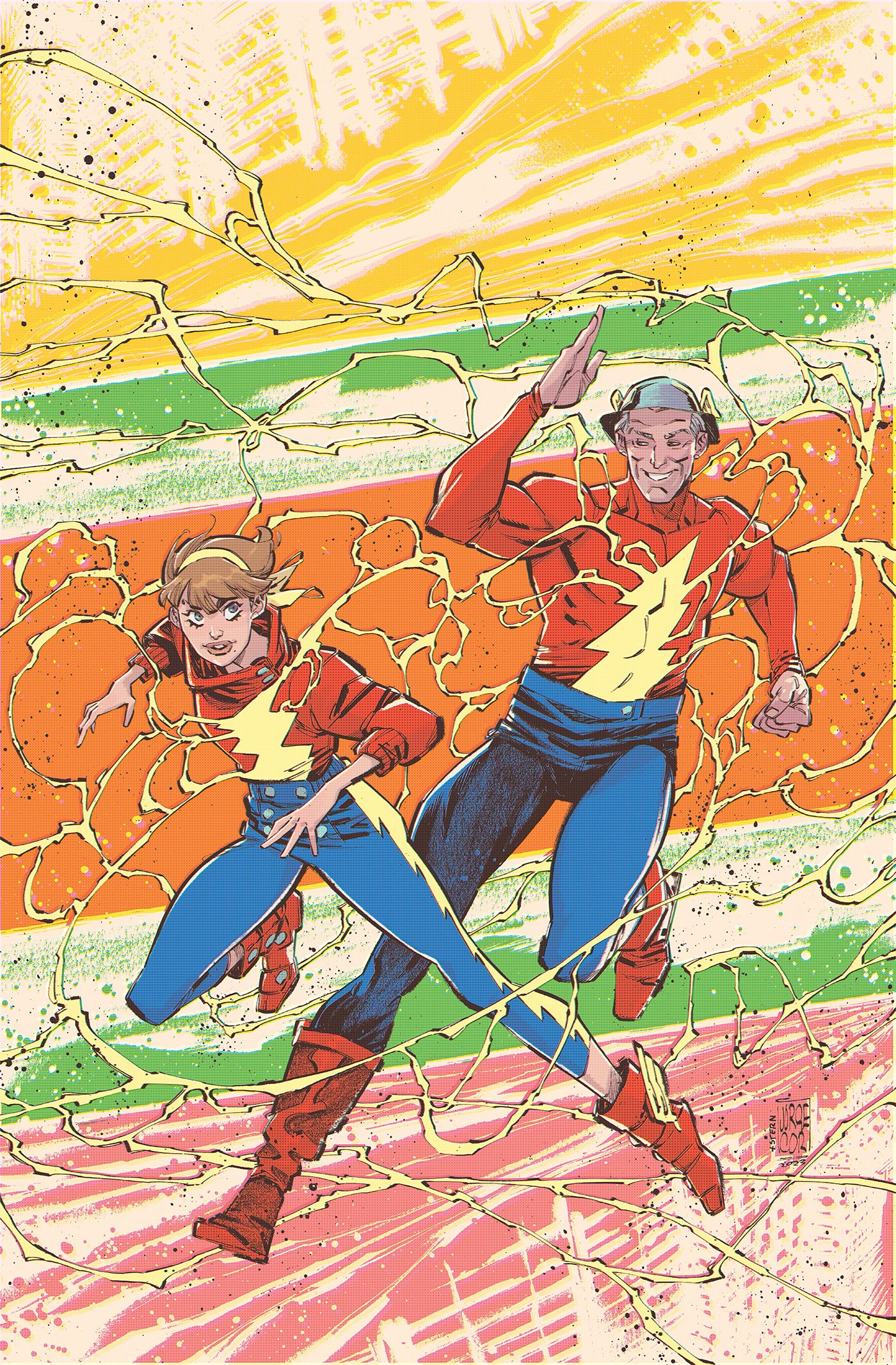The following contains spoilers for Stargirl: The Lost Children #6, on sale now from DC Comics.
Written by Geoff Johns and drawn by Todd Nauck, Stargirl: The Lost Children is one of two titles that spun out of The New Golden Age #1, the other being a new Justice Society of America series. Stargirl has now wrapped with its sixth and final issue, but more titles tying into The New Golden Age and Justice Society of America are on the way. DC announced that Flash Jay Garrick, Green Lantern Alan Scott, and Sandman Wesley Dodds will each headline their own New Golden Age series in the near future.
Stargirl: The Lost Children ends by introducing DC fans to the "Young Justice Society." Along with Stargirl, this team comprises the Golden Age sidekicks that were trapped on Orphan Island by the Childminder. As revealed in the final issue, a future version of Time Master Corky Baxter was working with the villain to capture the sidekicks and controlled Hourman to aid their schemes. Johns and Nauck sat down with CBR to discuss the finale of Stargirl: The Lost Children, how it ties into Justice Society of America, the future New Golden Age series, and their respective contributions to the upcoming anniversary issue, The Flash #800.
CBR: An adult Corky Baxter is revealed to be the villain controlling Hourman and buying the Lost Children from the Childminder. Where did this idea come from? Todd, did you consider any alternate looks for adult Corky?
Todd Nauck: I'll address the visuals here first. Geoff had mentioned in the script an adult, 45-year-old-ish Corky shows up, so I looked up some Time Master looks and found Dan Jurgens' Rip Hunter look. And it's like, "Let's take that" because Corky will have aged out of his Silver Age costume to something a little more current. Geoff said it should be tattered up, [so] it's like, "Okay, let's rip it up a little bit," and my favorite part was what we did with Crockett. Geoff said he needs to look sickly and tattered and ragged, so [he's] this squeaky-eyed raccoon. [Drawing a] feral raccoon was really fun. I did my initial take, and then Geoff said, "Can we rip up the costume a little bit more?" "Let's make him look really Thunderdome," is what I was thinking in my head. How do we Thunderdome this character in the future?
Geoff Johns: The idea behind Corky is simply [that] the whole story is a reflection of friendship. Thematically, you see Stargirl and the Lost Children come together, and in the same way [that] you see them come together, you see Corky unravel as this individual character who's got an agenda he's not sharing and thinks he's above it all and is trying to do it all himself, and ultimately, is spun around by the fact that these choices might lead him down this path and that he might be vindictive against these kids instead of calling them friends. Ultimately, Rip Hunter tells him, "Well, look, that version of you is now no longer going to exist. I've made sure that you're making different choices now." But it's a reminder and a lesson to Corky that causes him to question everything he's doing and also see how lonely his life really has become and can potentially be. So it points to the importance of friendship and the importance of opening yourself up to others. [Like] Courtney says at the end, you will get hurt by doing that. You'll get hurt by opening yourself to others, but you have to risk it. You have to be okay with it because otherwise, you're going to shut yourself off from everybody. I think it's important for everyone to know that it's not just about opening your heart, but it's about being aware enough that it won't always work out that way. And it hurts a lot, but you don't want to close yourself off. So everything in this story was pointing to that.
Talk to me about bringing back Hourman/Matthew Tyler for this series.
Johns: It points to friendship, but I wanted Courtney to go up against another friend she had to help. Stargirl, to me, is somebody that will always try and help people she cares about. It's more important to her than anything else to help people. It comes from probably her greatest wound of being abandoned by her father and then being embraced by her stepfather. She sees how important it was for her, [so] she's going to try [to] do that for everybody else. By having her face a friend that needed help, it made it just more powerful. Also, the Hourman is an amazing character. It's fun to have him back in the DC Universe, and you'll see him again in Justice Society of America.
Nauck: It was fun. It was fun to get Geoff's script because the twist. I get to read first. So when I get the script, and I read it's Hourman, it's like, "Oh my gosh!" For me, it was like, "Let's find the reference to make sure I get that costume right," and [I] just enjoy getting to draw such a great version of the Hourman legacy of heroes. Getting to draw the android Hourman was fun from a fan point of view.
What made you two involve Secret/Greta Hayes? Todd, we last saw her around when your time on Young Justice wrapped, and now she has her ghost powers back?
Nauck: Yeah, she did end up in Geoff and Mike McKone's Teen Titans book because she was going to [Cissie King-Jones/Arrowette's] private school, the Elias School. So we know Greta, the living girl, was there. Geoff surprised me again when we were doing [Stargirl Spring Break Special #1]. Courtney has the time flashforward. She gets that vision from the timestream and sees Wing and some shadowed kids. Geoff had mentioned that one is Dan the Dyna-Mite and the other one's Secret, and I'm like, "Secret! She's back? This is a story that I want to be a part of." When we finally get to reveal how Secret is now Secret again, I want to be able to draw that because Secret is my girl. She was one of the first characters I got to create for DC. So that's a story for another day -- how is she back? Because she's the character you have to kill to bring back because she's a dead girl. So how did that happen?
Johns: She has the ability to walk between life and death. So she can turn into Secret or be Greta, which I thought was an important continuation of her story. But I wanted to bring her back because Todd was drawing the book, quite frankly. She's one of my favorite characters that he ever worked with.
Stargirl and the Lost Children are set to appear as the "Young Justice Society" in Justice Society of America #6. What can we expect from this new super team, and how does it feel to have co-created its roster of heroes?
Johns: Courtney will bring a lot of these kids into Present Day. We'll see many of them in Justice Society of America #6 as they get adjusted to their new lives. One of them will join the Justice Society of America. Another one will be co-starring in a miniseries somebody else is writing that I'm really excited about. So it'll be fun to see them integrated in the DC Universe. But it was great. Creating characters with Todd was a blast because we created so many and talked about them, and they came to life so quickly. I love those "Who's Who" pages we did in [The New Golden Age #1]. Those were fun. A lot of fun.
Nauck: Geoff gave me some great jumping off points for each of these characters. Then [there was] the fun of looking back to who their mentor would be, and how do I [work out] the formula of the mentor and then the sidekick costume? You look at the mentor, and the sidekick always has a pared-down version of their mentor's costume. If the mentor has a full face mask, the kid either has a domino mask or very little covering [for] their head or face. Being able to tap into that Golden Age vibe was really fun in the whole design process for many of these new ones we'd be introducing.
Speaking of one of those sidekicks, Judy Garrick is said to be one of the most powerful of the Lost Children. What can you share about her involvement in Justice Society of America and her reunion with her father, Flash Jay Garrick?
Johns: You'll see the beginning of that in Justice Society of America #6. I'm very excited to introduce her into Jay Garrick's world. It will have a profound emotional impact, obviously, on him and the Flash Family in general.
Todd, how was it working on Judy Garrick? There were a lot of fun moments in this series with her, like learning how to vibrate through a wall. Well, she really exploded it, but tried to.
Johns: She did her best.
Nauck: [Laughs] Yeah, she did her best. Yes, absolutely. It was fun to design her costume and try to tap into the Jay Garrick aspects, the whole Mercury vibe. That's why she has the yellow headband. [That] was for Mercury's wreath crown thing. So it's like, "How can I incorporate some of these aspects of Mercury into her look and have that kind of Jay Garrick [style], but more of a feminine version [or] feminine fashion styling to her?" The capri pants [are] something that kind of taps into that Golden Age, more Silver Age sort of look, since she didn't really show up more into the Silver Age. How can I tap into that visually? Then, with the stuff Geoff was writing for how she's using her powers...and our tragic introduction of her... I mean, she's chained to a machine. That's the first time we're really getting to know the character. So her interactions with [Emiko Queen/Red Arrow] through the wall of the cells was really fun. [The] emotional moment of her having someone to actually interact with, and to help encourage her to step beyond what she knows, to try new things for better or for worse, it all worked out for the most part. I think we see in Issue #5, it got the job done. Clunky success is still success. So that was really fun to have those emotional moments as well as those superpower moments.
On the subject of Flash, you two are both working on The Flash #800 along with a number of other Flash creators, like Scott Kolins, 20 years after "Blitz." Artwork from the issue shows the return of Zoom, but what can you both share about your respective contributions to this anniversary issue?
Johns: You know, it's funny. Scott and I spoke about... They asked us to do a story for it, and we have revisited a lot of characters before. I love Wally West [and] grew up with him as the Flash. We've done a lot of Captain Cold stuff, and Scott said, "I'd love to do Hunter [Zolomon]. We haven't really done him together since 'Blitz.'" I sign "Blitz" copies at the comic shows every time I go. It seems to be one I sign a lot. So this is a pickup of Hunter Zolomon, reintroducing him to the audience, who he is, why he does what he does, and reaffirming how he's different than all the other superheroes. Hunter Zolomon's goal has always been to make Wally West the best Flash he can be, so we dive into that a little bit more. There was a revelation in Joshua Williamson's run that [Eobard] Thawne, the original Professor Zoom, had a hand in shaping Hunter's life, so we play with that a little bit. The art's gorgeous, just gorgeous. Scott's amazing.
Nauck: I get to do a story with Mark Waid. Our story taps more into like the mid '90s era Wally West. I'm not sure how much I can say about that story. I don't want to give away too much, but there will be some other Flash Family members in that story.
What always draws you two back to the Flash? What makes him such an attractive character to work on?
Johns: He's always been my favorite character since I was a kid. I always loved his look. I loved his powers, his villains, [and] his stories. He could fight a super giant, talking gorilla, or thugs with super weapons or travel through time or go to different dimensions. So his stories felt endless, and his characters felt so diverse. I've always been drawn to the character, and it was fun to go back to him.
Nauck: This is my first Flash story I've gotten to draw. I've drawn stories that have featured the Flash, but this is my first Flash-centric story because everything else I'd done at DC, for the most part, had either been Young Justice or Teen Titans. I hadn't really gotten to work with many other characters outside of those two corners of the DC Universe, though Wally did show up in things like Young Justice: Sins of Youth and things like that. So it's not like [I'm] a complete stranger to drawing Flash in a story, but this is my first time to have one that's really a Flash story, which was a lot of fun. My first exposure to the Flash was the Super Friends cartoon when I was a kid. I'd never seen the Flash before, and the first episode I saw that had the Flash on it, I grabbed my crayons and drew him because I thought I might not ever see this character again.
I was like six years old, and I just thought he was the coolest-looking character, and I thought being able to run fast -- that power could be attainable. Because any time you get new sneakers, you always run fast with new sneakers. You're always running faster whenever you get a new pair of sneakers. So I thought as a kid, maybe one day I could be the Flash, because I know I have the potential of running fast. My life did not take the turns I had hoped for in regards to developing superspeed. But as a kid, his look was so different from Superman, Batman [and] Aquaman. All that red and yellow, the speed, and the slipstream behind him was such a new visual for me. It excited me on so many different levels. So getting to do this story here with Mark has been just a fun little touchstone to be able to contribute just a little bit to the Flash legacy of stories.
Geoff, you're still working on Justice Society of America, and you just teased that there will be another JSA-related title on the way. Is there anything you two can tease about any future work you may have in the DC Universe?
Nauck: I think it has been mentioned [that] I'm doing a few pages in the Wonder Woman #800 issue, but other than that, mum's the word.
Johns: So one of the characters, Judy Garrick, who's obviously introduced in this and then she's gonna be Justice Society of America #6, you're gonna see a series written by Jeremy Adams, Jay Garrick: The Flash, that will feature Jay, Judy, and their first adventure together. It's the first solo title Jay Garrick's had since his own title. You'll also see, coming out of The New Golden Age and connected to Stargirl and all this stuff we've done, Alan Scott: The Green Lantern by Tim Sheridan, which will introduce and focus on Alan's origin and the story of his greatest enemy, the Golden Age Red Lantern.
Then, the third miniseries by Robert Venditti is Wesley Dodds: The Sandman, which will focus on an early adventure of Wesley Dodds through the lens of Oppenheimer and the chemical weapons he's created and what they unleash. Those are the early days leading up to him joining the JSA. [With] these three miniseries, Jay Garrick's takes place today, Alan's takes place in the past as does Wesley Dodds', but they will all tie back into Justice Society of America and be introducing new characters that will play a role in the JSA from yesterday up to today.
That all sounds amazing. I've wished DC would do more than one Flash title at a time, and it was so sad to hear that Adams' run is ending. So to hear that he's getting to do that is awesome.
Johns: Yeah, it's really cool. Jeremy's an amazing writer, so it's fun to see DC get behind the JSA in a way they haven't in a long, long time. Because these characters... to actually think about it, Jay and Alan, two of the biggest superheroes in DC, haven't had their own titles in so long. It's great to see them have them again.
Written by Geoff Johns and drawn by Todd Nauck, Stargirl: The Lost Children #6 is on sale now from DC.

